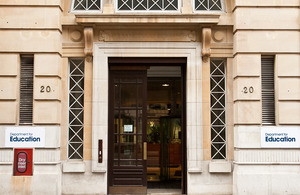Primary schools’ test results released
News on a bid to improve standards in primary schools.

Higher floor standards driving up performance
The Department for Education last year introduced new tougher floor targets for primary schools in a bid to drive up standards. As well as being higher, schools not meeting them faced similar consequences to what secondary schools faced.
Now, schools where fewer than 60% of pupils achieve at least the expected level (level 4) in English and maths combined, and are down on progress measures for English and maths, are deemed to be below the floor.
Results published today show that fewer schools are below the floor this year.
In 2011, 1,310 primary schools were below the floor.
This year 476 schools are below the floor. A further 45 were also below the floor but have since closed, 37 of them to become academies.
A Department for Education spokesman said:
This government brought in higher primary school floor targets with one aim in mind - to drive up standards with immediate effect to end years of chronic under-performance.
Today’s figures demonstrate that schools have responded to the challenge. The floor standards we introduced were tougher and have improved performance. Heads, teachers and pupils deserve credit for meeting the challenge head on.
Schools with a long history of under-performance, and who are not stepping up to the mark, face being taken over by an academy sponsor. The expertise and strong leadership provided by sponsors is the best way to turn around weak schools and give pupils there the best chance of a first-class education.
To be deemed below the floor, a school needs to be down on all three of the new measures that make up the primary school floor standard:
- Fewer than 60% of its pupils not achieving level 4 or above in English and maths combined.
- It is below the England median for progression by two levels in English - 92% this year.
- It is below the England median for progression by two levels in maths - 90% this year.
Key points
- Nationally, pupils improved in both the reading and the maths tests this year.
- There was no writing test this year. A new grammar, spelling and punctuation test will be brought in next year.
- The proportion of children who achieved at least the expected level (Level 4) in reading was up three percentage points to 87%. In maths it was up four points to 84%.
- There was a 6 point rise in English and maths combined, to 79%, although that figure is not directly comparable to 2011 because there was no writing test.
- The combined English score is made up of the reading test and teacher assessment of writing.
- In 502 primary schools, every child not only achieved at least the expected level in both English and maths, but also made the expected progress in both subjects.
Floor standards
Schools below the floor by region:
- Yorkshire and Humber - 6% (89 schools)
- East of England - 6% (78 schools)
- East Midlands - 4% (46 schools)
- South East - 4% (73 schools)
- North East - 3% (18 schools)
- South West - 3% (44 schools)
- North West - 3% (63 schools)
- West Midlands - 3% (47 schools)
- London - 1% (18 schools)
- Inner London - 1% (8 schools)
- Outer London - 1% (10 schools)
Local authorities with highest percentage of schools below the floor:
- Portsmouth - 16%
- Nottingham - 16%
- Kirklees - 11%
- Peterborough - 11%
- Medway - 11%
- Derby - 10%
- Norfolk - 10%
- Bristol - 10%
- Suffolk - 9%
- Thurrock - 9%
- North Lincolnshire - 9%
- Calderdale - 9%
- Wakefield - 9%
Academies
The ‘sponsored academy’ programme is in addition to the hundreds of schools which can convert to academy status (known as ‘converter academies’).
The academy programme was previously focused on under-performing secondary schools. This government is now using academies to tackle weak primary schools as well. It has also allowed schools to take advantage of the freedoms and autonomy on offer by academy status, by converting.
As at December 1, there are now 932 open primary academies in England - 751 are converter academies and 181 are sponsored.
DfE media enquiries
Central newsdesk - for journalists 020 7783 8300